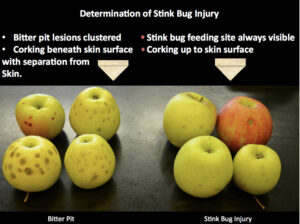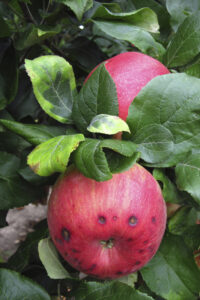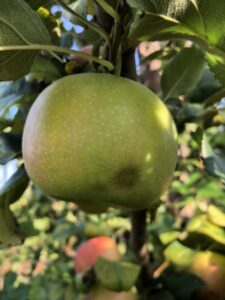In Indiana, our ‘normal’ or average weather is one of extremes, punctuated with an occasional glorious summer day of sun and 76 degrees F. This year has been one of flooding and droughts, freezes and scorching heat. Again. With these weather extremes come physiological disorders and summer fruit rots, for those lucky enough to even have a crop.
Physiological disorders in apples are easily confused with hail injury, disease, or insect damage (Fig. 1). Recognizing the different causes of these problems is important to implement the appropriate management to minimize or prevent the problem from occurring next year.
Bitter pit commonly presents during hot weather, and dry spells, particularly on varieties like Gala or Honeycrisp. Symptoms of bitter pit include circular or even irregular sunken spots on the fruit surface, beneath brownish or streaked dead regions (Fig. 2). The affected tissue in these pits is dark and spongy. Those brave enough to taste it may discover that it tastes…bitter, and simply quite terrible, for those wondering. I do the hard experimenting so you don’t have to!
Symptoms of bitter pit may be mistaken for hail damage, bitter rot, or any of the below problems. A key diagnostic feature is that hail usually affects only one side of the fruit, whereas bitter pit is more severe on blossom end of the fruit. Some varieties, like Honeycrisp, are more prone to this disorder, whereas hail will impact (literally) all varieties of fruit. Bitter pit can show up throughout the orchard, not just the edges, like one may observe with insect damage. Lastly, large fruit from trees with light crops are more likely to have bitter pit than trees that were adequately and not over-thinned. Lenticel spot, or lenticel rot are the names given to disorders of apple fruits whose symptom is a small brown or black spot centered on a lenticel. Lenticel spot, per se, is not caused by fungi or bacteria, although the spots may be invaded by opportunistic secondary rot fungi, like the bitter rot, white rot or black rot fungi, while fruit is stored. I have not recovered sufficiently from tasting bitter pit to see if the flavor of lenticel rot is something of diagnostic note.
Cork spot (Fig. 3) is another physiological disorder affecting the outer portion of the fruit. Symptoms begin on the fruit flesh as small dimples or depressions. This disorder begins developing in June, and continues throughout the growth and enlargement of the apple. Lesions enlarge to 1/4 – 1/2 inch corky, discolored areas in the flesh of the apple. Unlike bitter pit, the corky spots may occur anywhere on the apple. It is important to note that all of these problems are only surface blemishes. Unfortunately, their unattractive appearance often reduces the marketability of the fruit.
Bitter pit, lenticel rot and cork spot disorders can be mistaken for brown marmorated stink bug injury (BMSB) (Fig. 1,2). BMSB usually appears around the edges of the orchard, although I do question their literacy skills and their ability to follow directions. BMSB can occur all over the apple, and more around the shoulder than the calyx. There should be a ‘sting’ in the center of the depression—this is a key diagnostic feature.
For those that have had problems with these disorders: Bitter pit, lenticel rot, cork spot and Jonathan spot are complex problem that require an integrated management scheme to reduce the problem to acceptable levels. This was reviewed in a 2021 article that you can see here.
Recent research has found that ‘Honeycrisp’ trees on Budagovsky.10 (B.10) rootstock had the lowest bitter pit (BP) incidence; Honeycrisp on Vineland (V).6 rootstock had the highest, according to a study published in the journal Frontiers in Plant Science. 14 rootstocks were evaluated by Dr. Sherif Sherif’s team at Virginia Tech, including 14 rootstocks — B.10, (G).11, G.202, G.214, G.30, G.41, G.935, G.969, Malling (M).26 East Malling/Ashton Long (EMLA),
M.9, V.1, V.5, V.6, and V.7. Unfortunately, none of the popular Geneva (G)rootstocks examined in the study, such as G.11, G.30, G.41, G.202, G.241, G.935, and G.969, performed as well as B.10.
I don’t think anyone (including the author of the study) found this surprising, considering B.10 is an offspring of B.9. One problem with B.9 is getting it to the upper wire in a trellis system, in addition to a (slightly) delayed period to cropping compared to other rootstocks. However, the precocity of other rootstocks come at a cost, in this instance. As a fairly new rootstock, B. 10 demand exceeds supply right now, but it is something to consider with future plantings, coupled with the management outlined previously.
Table 1: Apple Rootstock info: B.10. From https://apples.extension.org/apple-rootstock-info-b-10/
| Characteristic | Detail | Description |
| Rootstock | B.10 | Formerly Bud. 62-396. It is a release from the Michurinsk University of Agriculture (Russia) breeding program, which is trying to select for improved winter hardiness. A 10-year trial in Pennsylvania with Golden Delicious as the scion cultivar showed that trees on this rootstock were similar in size to trees on G.935 and M.9 T337 (15 percent smaller). Main scaffold branch angle was close to 90 degrees. Production efficiency and total yield were slightly better than trees on M.9 T337.
Cold hardy, yield efficient, Fireblight tolerant, with good root anchorage and stress tolerance. Production is similar to M-9. |
| Synonyms | Bud 10, Budagovsky 10 | |
| Origin | Malling 27 X Robusta 5 | |
| Availability | Commercial | |
| Tree Size | ||
| Precocity | Very early | |
| Winter Hardiness | Very Hardy | |
| Suckering | ||
| Tree Support Needed | ||
| Where tested within NC-140 or other research plantings | BC, CHIH, CO, IL, IN, IA, MA, MN, MI, NJ, NS, NY-G, OH, UT, WI |
References and additional information:
Bitter pit control in apples. Available at: http://www.omafra.gov.on.ca/english/crops/facts/00-009.htm
Rosenberger, D.A., J.R. Schupp , S.A. Hoying , L. Cheng, and C.B. Watkins. 2004. Controlling Bitter Pit in ‘Honeycrisp’ Apples. HortTechnology 14(3) 342-9.
http://horttech.ashspublications.org/content/14/3/342.full.pdf
Bitter pit versus stink bug. http://blogs.cornell.edu/jentsch/2014/09/18/bmsb-update-assessing-fruit-damage-at-harvest-is-it-hail-bitter-pit-apple-maggot-or-stink-bug/


